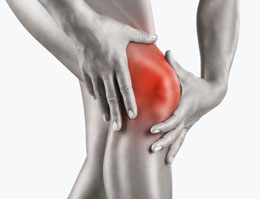Is there a connection between acidic foods and joint pain? Does having too many acidic food items in your diet make you more susceptible to painful, inflamed joints? Let's go get some answers!

You must have noticed how foods that tempt the tongue the most are the ones that give your health a
thumbs down without fail every time you endeavor to indulge your sense to their gustatory pleasures! Well, now take a closer look at all those yummy food items without which life seems to lose its meaning - steaks, chocolates, bacon, fries, cheese, full cream seasonings, desserts, etc. - and you'll find out that almost all of these incredibly attractive edibles have a moderate to high acidic pH!
So what does that have to do with our health issues? After all, we do need certain acids to maintain the health and fitness of our bodies, don't we? Why else would dietitians and nutritionists blow their tops, singing praises over the health benefits of vitamins B
5 (pantothenic acid), B
9 (folic acid), and vitamin C (ascorbic acid)? Surely they haven't lost their minds! So what is it about acidic foods and joint pain (as well as other health issues) that prompt so many among us to switch to a predominantly alkaline diet plan at the cost of giving up a lot of our favorite edibles? The following segment holds the answer.
Joint Pain and Acidic Foods
The internal pH of the body is slightly on the alkaline side, with blood, the most abundant biological fluid, having a pH that ranges between 7.35 and 7.45. Most of us are aware that the blood presents a neutral environment which discourages the survival or growth of micro organisms in it. Now, any figure above 7 on a pH scale depicts alkalinity, while any figure below 7 on the pH scale shows an acidic tendency. Therefore, having a pH value between 7.35 and 7.45, the blood can be said to hover between a neutral to slightly alkaline pH, but in no way acidic. While the body is capable of maintaining a balance between acid and alkaline tendencies within itself, an excessive introduction of acids via food sources can, temporarily, tip the scales. If this balance is frequently or continuously tipped in favor of acids, the body can become a victim to a lot of health issues, ranging from something as simple as acid reflux to something as life-threatening as cancer.
The particular acid whose excess in the body causes joint pain is uric acid. This acid is produced as a final product when the body metabolizes purine, which is an organic compound that is a part of the composition of the monomer building blocks of DNA and RNA. Apart from the purine that naturally occurs inside our bodies, we also introduce extra units of this organic compound when we consume foods that are sourced from animals, with products of meat, poultry, dairy, etc. More purine inside the body means higher levels of uric acid. While uric acid is a strong reducing agent which is responsible for as much as 50% of the antioxidant capabilities of blood plasma, excess of this compound can lead to the formation of uric acid crystals that do not get excreted via the urine. These crystals accumulate at the joints, causing them to swell, become stiff and painful. This condition is medically known as
Gout and it is a type of arthritis. Eating tofu, lime, bananas, apples, blue berries, cherries and such other foods that lower uric acid, help ease the condition to a great extent.
Another condition know as
acidosis, is caused by consuming an excess of foods that have a high acid content. This condition is characterized by the pH of the blood going below 7, indicating the acidification of the haematic environment. This condition also leads to pain and stiffness in the joints, as the bloodstream attempts to get rid of the excess acids by dumping acidic toxins and various minerals (formed into crystals) along the joints, causing them to become inflamed, stiff and painful.
Besides pain and swelling in the joints, other indicators of acidosis include heartburn, fatigue, headaches, drowsiness, respiratory difficulties, gastric problems, muscular seizures and weakness, etc. So, as we can see, an increased intake of acidic foods does the body more harm than good. However, this does not mean that you should totally exclude acids from your diet, as too much alkalinity leads to a faster rate of cellular death. To put together a pH balanced diet plan, the trick is to choose low acid foods such as legumes and white meat, over high acid ones such as red meat. Strike a balance to stay healthy.


 You must have noticed how foods that tempt the tongue the most are the ones that give your health a thumbs down without fail every time you endeavor to indulge your sense to their gustatory pleasures! Well, now take a closer look at all those yummy food items without which life seems to lose its meaning - steaks, chocolates, bacon, fries, cheese, full cream seasonings, desserts, etc. - and you'll find out that almost all of these incredibly attractive edibles have a moderate to high acidic pH!
You must have noticed how foods that tempt the tongue the most are the ones that give your health a thumbs down without fail every time you endeavor to indulge your sense to their gustatory pleasures! Well, now take a closer look at all those yummy food items without which life seems to lose its meaning - steaks, chocolates, bacon, fries, cheese, full cream seasonings, desserts, etc. - and you'll find out that almost all of these incredibly attractive edibles have a moderate to high acidic pH!